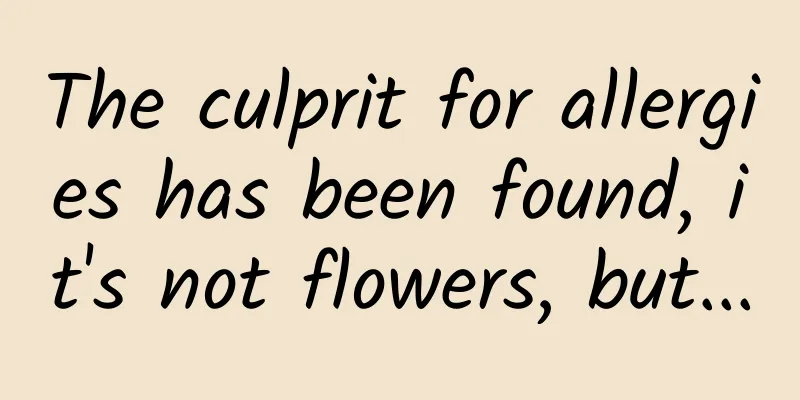The culprit for allergies has been found, it's not flowers, but...

|
Audit expert: Gu Haitong Beijing Tongren Hospital, Capital Medical University Deputy Chief Physician of Respiratory Medicine In spring, everything grows, and trees and flowers gradually begin to sprout and bloom. But when you walk on the street, you may find that many people have runny noses and sneezing. Most people think that this may be caused by the flu. In fact, in addition to the flu, there is another condition that can cause people to have cold-like symptoms, that is, pollen allergy. According to pollen monitoring data from medical institutions, Beijing has now entered the peak season of spring pollen. The data shows that the concentration of major allergenic pollen in the air has reached more than 3,000 grains per thousand square millimeters. In recent days, sandstorms have also occurred, and many people have reported that allergic symptoms have recurred. Source | pexels What is pollen allergy? Pollen allergy, also known as hay fever, is a disease of respiratory allergy caused by pollen, also known as "seasonal allergic rhinitis". When people inhale pollen, an antibody will be produced in the body. If the amount of this antibody exceeds the body's tolerance, the body will experience a series of uncomfortable symptoms. Modern medicine believes that this is a series of pathological and physiological processes caused by atopic patients being sensitized by pollen. There are many trees that are most likely to cause pollen allergies, such as willows, poplars, elms, sycamores, etc. Spring is not friendly to people with "allergic constitution". Once the patient's skin and respiratory tract come into contact with pollen, they will have an allergic reaction, with symptoms such as itchy eyes, nasal congestion, runny nose, sneezing, etc. In severe cases, dermatitis, urticaria, and even asthma may occur, which greatly affects physical health and quality of life. It can be said that spring is a season that makes people with pollen allergies miserable! Source: pixabay In recent years, with the increase in environmental pollution, the number of people suffering from hay fever in my country has been on the rise. According to a report by CCTV Finance Channel in 2022, the number of patients with allergic rhinitis in China has reached 240 million. Unlike colds, hay fever has nothing to do with resistance, but is related to the degree of immune response. Although the symptoms are similar to those of colds, there is no fever and the duration is long. It is divided into seasonal and perennial onset. It is still incurable at present, but the symptoms can be alleviated through treatment. If you find that your "cold" has not improved and is not getting worse, you may want to go to the hospital to check whether it is allergic rhinitis caused by hay fever. Friends who are diagnosed with hay fever need to further understand which pollen allergens cause the disease. Who is the culprit of allergies? Although we cannot see pollen with our naked eyes, the wide range and speed at which pollen spreads are unimaginable. There are two ways of pollen transmission: wind-pollinated and insect-pollinated. "Insect-pollinated flowers" collect and spread pollen through insects. The pollen particles are large, the number is small, and the range of transmission is also limited. Most of them come from bright and beautiful flowers, such as peach blossoms, roses, roses and other ornamental flowers, but they are not the main source of pollen allergies. The real pollen "culprit" is "wind-pollinated flowers", which come from some inconspicuous grasses and trees on the road. Their pollen particles are light and small, but the number is huge. With the wind, they can spread several kilometers away, or even across the ocean. Therefore, as long as you are outdoors, you will inevitably be exposed to pollen. In different seasons, pollen allergens vary according to the flowering period of plants, so we will find that hay fever has seasonal characteristics. If you want to know which allergens correspond to different seasons, the summary is: look at trees in spring and grass in autumn. Generally speaking, pollen from March to May mainly comes from trees, including poplar, cypress, sycamore, ginkgo, ash, etc. In addition to pollen, some willows and sycamores that produce flying catkins can also cause allergic reactions. The probability of suffering from hay fever in Japan is as high as 25%. The reason is that Japan grows a large area of cedar, and the amount of pollen in cedar is particularly large. When the wind blows, you can see its light yellow pollen mist. The default source of hay fever allergens in Japan comes from cedar trees. Source of Cryptomeria branches: pixabay As the seasons change, pollen from grasses has become a major allergen, such as corn, wheat, sorghum, foxtail grass, etc. These are very common plants in our lives, with a wide distribution range, and are easily avoided by wind-borne transmission. A single corn plant can produce four to five million pollen particles. In summer and autumn, the flowering period of Artemisia plants in the Asteraceae family begins. According to surveys, Artemisia pollen is one of the main allergens for allergic rhinitis in northern and northwest my country. Although Artemisia can prevent wind and fix sand, and has a purifying effect on desert ecology, its pollen has a greater impact on human health due to large-scale planting, and its use in aerial seeding afforestation has been gradually stopped. Source of Artemisia | Baidu Encyclopedia Common allergenic pollens include the grass in North China and the alien species ragweed. It can be said that the air we breathe every day is full of pollen. So do patients with allergic rhinitis really sneeze all year round? How to relieve pollen allergy? Although pollen allergies cannot be avoided, they can be mitigated and treated. First of all, you still need to go to the hospital to check your allergens. According to the results of the examination, identify the allergens around you and stay away from them. Secondly, in terms of lifestyle habits, under the influence of the epidemic, everyone has become accustomed to wearing masks when going out, which not only prevents the spread of colds, but also effectively reduces pollen inhalation. Severe patients can wear goggles to reduce skin contact. During the pollen season, the pollen concentration is high from 10 am to 5 pm every day. People with respiratory symptoms such as allergies and asthma should try to avoid going out. If you have to go out, you should wear a mask, goggles, etc. for protection. If you are exposed to more allergens outside, When you get home, change your clothes promptly, and wash your hands, eyes, and nose. You can also use pollen blockers. In your daily life, pay attention to the pollen concentration reports released by local meteorological bureaus, plan your travel, etc. Source: pexels Third, drug treatment is available. Common drugs include glucocorticoid nasal sprays, antihistamines, anti-leukotriene drugs, nasal decongestants, etc., which can relieve rhinitis symptoms such as nasal itching, nasal congestion, and sneezing. Patients can use medication before the peak allergy season begins, but they need to be taken continuously and symptoms may recur. Asthma inhaler source: pixabay Finally, there is an immunotherapy, also known as desensitization therapy , which can achieve a radical cure to a large extent. If the allergen is clinically identified, desensitization therapy can be performed. At present, only domestic allergens can be selected for desensitization treatment of pollen in China. Desensitization treatment can be performed for pollen from cypress and sycamore trees in spring, wormwood pollen and green grass pollen in autumn. In fact, pollen allergy is caused by the body's over-immunity after exposure to pollen, which produces specific antibodies and causes a self-attack reaction. Immunotherapy is to let the patient contact the allergen, multiple times and in small amounts, to form adaptability and reduce the response of the immune system. Commonly used treatments include sublingual tablets, drops and subcutaneous injections. The patient's condition needs to remain stable before immunotherapy can be tried. Regardless of which method is used, the treatment time lasts at least three years, which is very long and requires multiple follow-up examinations to determine the body's immune status. In short, everyone should decide whether to take medication and immunotherapy based on their own allergic reactions. In spring, although the flowers and plants are very beautiful, everyone should still take good protection when going out, and clean the house frequently to keep it clean and hygienic. |
<<: What is it like to be at the scene of a volcanic eruption?
Recommend
Wearing a mask for a long time can cause lung nodules to grow larger? Don't believe these rumors
The weather will become colder when the Earth rea...
VLC-based video player
I've been researching the video playback func...
King crabs are rampant. Is eating them saving the ecology?
As the saying goes, "scarcity makes things v...
There is a "microbial city" in our mouth
The invention of the microscope first expanded pe...
Does AI have consciousness? Let’s start with the definition of consciousness
Scientists who rarely explore human consciousness...
Group buying ends: How does Hongtu Sanbao “blend” Lashou?
After a long wait, the second shoe finally droppe...
Cold wave + strong wind + sandstorm! If you are preparing to start work, please take these precautions!
1Cold wave orange warning! The Central Meteorolog...
How to send birthday wishes to Africans? How much does it cost to raise a sign to bless in Africa?
With the arrival of Chinese Valentine's Day o...
How does Toutiao build the user life cycle?
I have met some friends who can talk eloquently a...
The “universal” methodology for bidding advertising!
The editor has personally operated and placed adv...
Xcodeghost ends, more than 300 popular apps infected with malicious programs, virus creator identified
Recently, the iPhone versions of many well-known ...
AirPods wish list? Analysts mention these three
Apple's launch of AirPods was not smooth saili...
How to go on my Android road~
Many students who do Android development want to ...
Six tips for navigation bars
`UINavigationBar` and `UINavigationItem` are comm...









